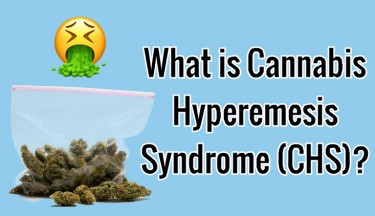
Cannabinoid hyperemesis syndrome (CHS) is real, but genetic testing can help find the answers
With a disease condition as severe as cannabinoid hyperemesis syndrome, one can only guess how rare the condition is.
First observed in 2004 with fewer than 200 cases observed over the years, CHS was very difficult to diagnose.
No one imagined that cannabis could trigger the symptoms associated with this condition, as most of these symptoms are the original reason the patient started taking the drug. Ironic!
Currently, information about this disease condition is limited, not all doctors are able to correctly diagnose the disease due to its rarity and poor understanding of the disease.
What is cannabinoid hyperemesis syndrome (CHS)?
This is a recently discovered disease condition that occurs in people affecting common cannabis users.
CHS is a disease that causes marijuana users to be highly sensitive to cannabinoid compounds – especially THC.
On average, one case of cannabinoid hyperemesis syndrome is diagnosed in a month. The limited availability of this drug has led scientists to suggest that genetics play an important role in those affected.
Diagnosis of cannabinoid hyperemesis syndrome
CHS is a difficult condition to diagnose. The symptoms associated with the condition are very common and can be seen with other conditions. Patients also tend to deny their use of cannabis drugs while consulting with their doctors.
CHS is often diagnosed when other suspected conditions have been cleared.
The steps to an official diagnosis of CHS were difficult and costly. The medical staff was initially confused and a lot of money was invested in accurately diagnosing the cause of the symptoms observed.
A 2019 study claims that an estimate of over $ 76,000 was used up on various diagnostic tests
Cannabinoid Hyperemesis Syndrome. Sometime in 2018, a study found that a visit to the emergency room for a CHS-related diagnosis could cost as much as $ 4,600 for an average patient.
With increasing cannabis reform policies in all countries of the world, awareness of CHS conditions would increase. It will be easier for healthcare professionals and patients to properly identify the condition, thereby reducing the associated cost of performing various tests.
Scientists have also looked into the condition and are determined to get more information about CHS. The information available is limited and unable to educate people at risk about the pros and cons of the disease.
Step by step, researchers will identify clear markers that can be used to diagnose cannabinoid hyperemesis in record time.
Causes of Cannabinoid Hyperemesis Syndrome
Of studies done over the years, one thing is common; all patients have a record of frequent marijuana use. It has been found that CHS occurs in a very small percentage of regular and long-term users of cannabis flowers or products.
Some researchers suggest that genetics may play a huge role in the development of this condition in an individual, on the other hand, some researchers claim that CHS has been linked to chronic marijuana use.
Research is being carried out to prove either or both of these claims. Further studies will uncover more complex information about CHS.
Dr. Ethan Russo, a renowned forerunner in cannabis research, explains that while more research is being conducted to learn more about CHS, it is fair to say that CHS could be due to a rare genetic disease caused by excessive cannabinoid intake is induced.
CHS is not caused by pesticides
Unconfirmed claims that CHS is caused by compounds found in pesticides have been made by Dr. Russo refuted. The pesticides and neem oil used by cannabis growers in no way cause CHS in chronic cannabis users.
If pesticides had indeed been the cause, we would have seen very high incidence of the disease in thousands of people as there are more pesticides today than when CHS was first observed in 2004.
It is also important to note that CHS has been identified in users of synthetic cannabinoids and that these synthetic compounds, while strong, do not contain a pesticidal compound.
Role of genetics in diagnosing cannabinoid hyperemesis syndrome
There is just enough information available to draw a vague sketch to describe how genetic testing could be used to diagnose CHS in the human body.
Dr. Russo, with the support of Endocanna Health, a cannabis genetics company, is conducting the first and largest study focused on cannabinoid hyperemesis syndrome.
The team extracted the genetics of 28 patients previously diagnosed with CHS.
After careful experimentation, the team was able to locate five gene mutations that appear to play an active role in the development of CHS. These gene mutations are known as single nucleotide polymorphisms (SNPs). The gene mutation of these five genes causes a deviation from the body’s mood regulation, dopamine activity, bowel function and pain response.
The five genes studied are:
-
COMT gene
-
CYP2C9 gene
-
ABCA1 gene
-
TRPV1 gene
-
DRD2 gene
There is so much more to be learned about the effects of genes on the development of CHS. However, this study has helped provide the medical community with additional guidance on how to diagnose CHS.
Symptoms of cannabinoid hyperemesis syndrome
When a person has CHS, the body experiences sudden stimulation of the endocannabinoid system, as well as other receptors and systems that surround and work with that ECS.
Observable symptoms include:
-
Nausea
-
Vomit
-
Stomach cramps
-
fatigue
These symptoms recur every few weeks or months. If not treated properly, these symptoms can become severe and may result in an emergency drive to the emergency room.
Conclusion: treatment of cannabinoid hyperemesis syndrome
CHS patients have said that hot showers or baths help relieve their symptoms, albeit temporarily. Another temporary relief is applying capsaicin cream to the skin. Antipsychotics sometimes help some patients manage the symptoms of CHS.
None of the above methods can provide lasting relief to the patient. The permanent solution to cannabinoid hyperemesis syndrome is complete abstinence from cannabis and its by-products.
Waiting for a few weeks or months will temporarily stop all symptoms, and as soon as the user resumes using cannabis, symptoms start again.
DO YOU THINK YOU HAVE CHS OR “GREEN OUT” READ THIS …

WHAT IS GREEING OUT AND IS IT PART OF CHS ISSUES?
OR..

CANNABIS AND GREENING OUT, WHAT’S THE REAL DEAL?

Post a comment: